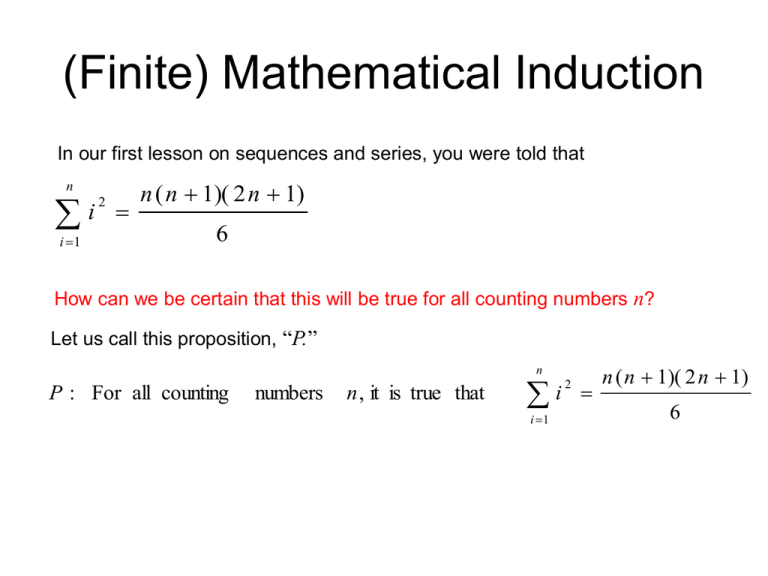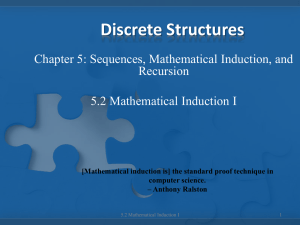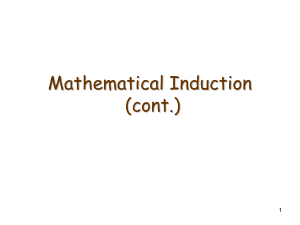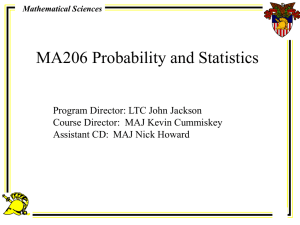(Finite) Mathematical Induction
advertisement

(Finite) Mathematical Induction In our first lesson on sequences and series, you were told that n i i 1 2 n ( n 1)( 2 n 1) 6 How can we be certain that this will be true for all counting numbers n? Let us call this proposition, “P.” n P : For all counting numbers n , it is true that i i 1 2 n ( n 1)( 2 n 1) 6 (Finite) Mathematical Induction n P : For all counting numbers i n , it is true that 2 n ( n 1)( 2 n 1) 6 i 1 This proposition P is logically equivalent to asserting all of the following, together: P1 : 1 2 1(1 1)( 2 1 1) 2 2 ( 2 1)( 2 2 1) 2 2 P6 : 1 2 ... 6 2 2 3 ( 3 1)( 2 3 1) 2 2 2 2 2 6 P4 : 1 2 3 4 2 2 P7 : 1 2 ... 7 P8 : 1 2 ... 8 2 2 2 6 P3 : 1 2 3 2 2 6 P2 : 1 2 2 P5 : 1 2 ... 5 2 4 ( 4 1)( 2 4 1) 6 2 2 5 ( 5 1)( 2 5 1) 6 6 ( 6 1)( 2 6 1) 6 7 ( 7 1)( 2 7 1) 6 8 ( 8 1)( 2 8 1) … and continuing for all the counting numbers. 6 (Finite) Mathematical Induction n P : For all counting numbers i n , it is true that 2 n ( n 1)( 2 n 1) 6 i 1 P1 : 1 2 1(1 1)( 2 1 1) 2 2 ( 2 1)( 2 2 1) P3 : 1 2 3 2 2 2 6 2 2 2 4 ( 4 1)( 2 4 1) 6 2 2 P6 : 1 2 ... 6 2 6 3 ( 3 1)( 2 3 1) P4 : 1 2 3 4 2 2 6 P2 : 1 2 2 P5 : 1 2 ... 5 2 2 P7 : 1 2 ... 7 2 2 2 P8 : 1 2 ... 8 2 2 2 5 ( 5 1)( 2 5 1) 6 6 ( 6 1)( 2 6 1) 6 7 ( 7 1)( 2 7 1) 6 8 ( 8 1)( 2 8 1) Taken by itself, each of these individual propositions is simple to verify: simply compute each side of the equation and check that they are equal. But a proof can’t go on forever. We must find another way to prove P. 6 (Finite) Mathematical Induction The situation could be like this: P1 P2 P3 P4 P5 P6 If there are infinitely many of these, and you need to knock over every one of them, you will never be finished. (Finite) Mathematical Induction However, if they were arranged like this: P1 P2 P3 P4 P5 P6 Even if there are infinitely many of them, one push (to knock over P1) will knock over all of them. (Finite) Mathematical Induction Method for knocking over infinitely many dominos: Method for proving infinitely many propositions: 1. Make sure that each domino, Pk, will knock over the next one, Pk+1. 1. Prove that each proposition, Pk, implies the next one, Pk+1. Pk Pk+1 2. Knock over the first domino, P1. “If Pk is true, then Pk+1 must also be true. 2. Verify the first proposition, P1. (Finite) Mathematical Induction P1 : 1 2 1(1 1)( 2 1 1) 2 6 P2 : 1 2 2 P3 : 1 2 3 2 2 ( 2 1)( 2 2 1) 2 Pn : 1 2 ... n 2 2 Pk : 1 2 ... k 2 2 2 Pk 1 : 1 2 ... k ( k 1) 2 2 2 2 3 ( 3 1)( 2 3 1) 6 P4 : 1 2 3 4 6 2 2 2 2 2 2 4 ( 4 1)( 2 4 1) 6 n ( n 1)( 2 n 1) 6 k ( k 1)( 2 k 1) 6 ( k 1)(( k 1) 1)( 2 ( k 1) 1) 6 Remark 1: If you include the “k” along with the “k+1” on the left-hand side, you will be glad you did. Remark 2: When you simplify, be flexible. Your goal is to show that two expressions are equivalent. (Finite) Mathematical Induction The two parts of a finite mathematical induction proof: 1) Verify P1 EASY! 2) Prove: if Pk is true, then Pk+1 must also be true. Pk Pk+1 Verifying P1 is usually so easy that it’s hard to say much about it. P1 : 1 2 1(1 1)( 2 1 1) 6 However, there are some cases where P1 is actually the difficult part. (Finite) Mathematical Induction The two parts of a finite mathematical induction proof: EASY! 1) Verify P1 2) Prove: if Pk is true, then Pk+1 must also be true. Pk What we must do: Assume that Pk is true, and then prove that Pk+1 must be true. What can we use? We can use any algebraic techniques, but we can also use Pk. How do we use Pk? Pk : 1 2 ... k 2 2 2 k ( k 1)( 2 k 1) 6 Usually by substitution: any occurrence of the left-hand side can be replaced with the right-hand side. Pk+1 (Finite) Mathematical Induction The two parts of a finite mathematical induction proof: EASY! 1) Verify P1 2) Prove: if Pk is true, then Pk+1 must also be true. Pk : 1 2 ... k 2 2 2 k ( k 1)( 2 k 1) Pk Pk+1 6 Where do we start? Examine Pk+1 and try to find where the left-hand side Pk of occurs in it. Pk 1 : 1 2 ... k ( k 1) 2 2 2 2 ( k 1)(( k 1) 1)( 2 ( k 1) 1) 6 Replace this occurrence of the left-hand side of Pk with the right-hand side. k ( k 1)( 2 k 1) 6 ( k 1) 2 ( k 1)(( k 1) 1)( 2 ( k 1) 1) 6 (Finite) Mathematical Induction The two parts of a finite mathematical induction proof: EASY! 1) Verify P1 2) Prove: if Pk is true, then Pk+1 must also be true. k ( k 1)( 2 k 1) ( k 1) 2 6 ( k 1)(( k 1) 1)( 2 ( k 1) 1) 6 Now it should be possible to prove that the two sides are in fact equivalent. Tip: Since one side (the right-hand side) is a single fraction, try making the other side be a single fraction. k ( k 1)( 2 k 1) 6 ( k 1) 6 2 ( k 1)(( k 1) 1)( 2 ( k 1) 1) 6 Tip: Since the denominators are the same, all we need do is prove that the numerators are equivalent. (Finite) Mathematical Induction The two parts of a finite mathematical induction proof: EASY! 1) Verify P1 2) Prove: if Pk is true, then Pk+1 must also be true. k ( k 1)( 2 k 1) 6 ( k 1) 2 6 ( k 1)(( k 1) 1)( 2 ( k 1) 1) 6 Simplify both numerators. Hopefully they will simplify to the same expression. Left-hand side: Right-hand side: k ( k 1)( 2 k 1) 6 ( k 1) ( k k )( 2 k 1) 6 ( k 1) 2 2 2 ( k 1)(( k 1) 1)( 2 ( k 1) 1) ( k 1)( k 2 )( 2 k 3 ) 2 k 3 k k 6 ( k 2 k 1) ( k 3 k 2 )( 2 k 3 ) 2 k 3 k k 6 k 12 k 6 2 k 3k 6 k 9 k 4 k 6 2 k 9 k 13 k 6 2 k 9 k 13 k 6 3 3 3 2 2 2 2 2 2 3 3 2 2 2 (Finite) Mathematical Induction The two parts of a finite mathematical induction proof: EASY! 1) Verify P1 2) Prove: if Pk is true, then Pk+1 must also be true. What did we just accomplish? We just proved to ourselves that if Pk is true, then Pk+1 must also be true. Now we are ready to write the proof. (Finite) Mathematical Induction n Using mathematical induction, we will prove that i 2 6 i 1 When n = 1, 1 i 1 i 1 1 2 2 and 1(1 1)( 2 1 1) 6 So the proposition is true when n = 1. 1 2 3 6 n ( n 1)( 2 n 1) 1 (Finite) Mathematical Induction Induction hypothesis: the proposition is true when n = k. k i 2 k ( k 1)( 2 k 1) 6 i 1 Now, to prove the proposition when n = k + 1, k 1 k i 2 i 1 i 2 ( k 1) 2 k ( k 1)( 2 k 1) 2 6 i 1 ( k 1) k ( k 1)( 2 k 1) 6 ( k 1) 2 2 k 9 k 13 k 6 3 6 Also, ( k 1)(( k 1) 1)( 2 ( k 1) 1) 2 6 2 k 9 k 13 k 6 3 2 6 6 Thus, if the proposition is true for n = k, it is true for n = k + 1. Therefore the proposition is true for all counting numbers n. QED.







